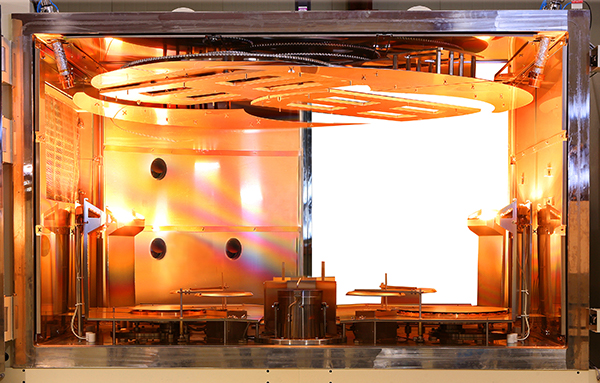From thermal vacuum deposition to the latest plasma assisted deposition, our multilayer thin film coatings can be tailored to your exact performance requirements. We operate our thin film coating systems in a dedicated clean room area to ensure quality. All our coatings conform to strict military and industrial specifications. Our coating chambers all feature state-of-the art computer controlled coating processes, optical monitors and crystal oscillators for deposition rate control.

Thin Film Coating Processes
- Thermal vacuum deposition
- E-beam deposition
- Ion assist e-beam deposition
- Plasma assist e-beam deposition
Our plasma assist e-beam deposition system provides cutting-edge thin film coating performance. Its high current deposition method produces thin films with higher density, lower internal stresses and higher adhesion than conventional ion assist deposition. Plasma assist coatings offer advances in key performance characteristics like zero optical shift and increased durability. Compared to conventional thin film coating methods, plasma assist deposition substantially improves IR coatings and low absorption UV coatings. This chamber enables Inrad Optics to coat single parts up to one-meter in diameter or process multiple smaller parts in high volume; five parts up to 28-inches in diameter can be coated at one time.
Inrad Optics coatings pass the temperature, abrasion, adhesion, humidity, salt fog and solubility demands of MIL-PRF-13830 and MIL-C-48497. We test each of our coating designs to ensure they meet specified laser damage thresholds.
Materials
We have an extensive back-catalogue of optical coating formulas for substrate materials from optical glass and crystalline materials to bare and nickel-plated metals. Our thin film depostion coatings employ oxide and fluoride dielectric multilayer coating materials including MgF, SiO2, TaO5, and HfO2 . We also offer enhanced and protected metallic coatings of gold, silver,and aluminum. Our current coating line-up covers a nominal wavelength range from 193nm - 12µm.
Coating Types
- Anti-reflective coatings
- High reflective coatings
- Partially reflective coatings
- Polarizing coatings
- Beam splitter coatings for the UV, visible, and infrared
- Neutral density filters
- Protective and enhanced aluminum, silver and gold coatings
